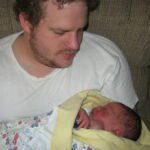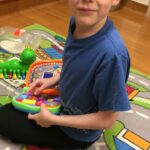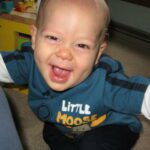Oliver, asymptomatic, but diagnosed with Juvenile GM1
In October 2008, Joseph was born big and healthy, and he grew and developed normally through infancy and toddlerhood. He walked just after a year old and was putting words together in short phrases by two. He loved to be silly and people frequently commented on his adorable dimples.
When Joey was three years old, we noticed that he had a few quirks- he had an odd but completely understandable pronunciation of words, and he was very cautious. Relatives commented that it sounded like he had an accent, and he disliked swings or anything that made him feel off-balance. At that time, we just chalked it up to a personality quirk, as he was otherwise developmentally normal. As Joey approached 5 years old, his development seemed to slow down, and by the time he was 5 ½ we were concerned enough about a few things we were noticing that we had him checked out by the pediatrician, but were told he was fine. At his 6-year-old well-child checkup I expressed my concerned about his motor delays and coordination issues, but Joey was friendly and happy and cooperative and the pediatrician told me that he seemed just fine to her. I thought maybe I was just overly worried about nothing, and maybe he was just a late bloomer and would catch up in his own time.
That did not happen. By the time I brought Joey in for his 7-year-old check-up, I was certain that there was something going on, but I couldn’t figure out what it could be. He saw a different pediatrician than the previous year who took my concerns seriously and referred him to a developmental pediatrician, as well as for Occupational Therapy. He started OT shortly after, and at the recommendation of the therapists we also started Speech Therapy, even though I was a bit skeptical at that point about whether it was necessary. A few months later we had the appointment with the Developmental Pediatrician and received a laundry list of diagnoses: Developmental Coordination Disorder, Fine Motor Delay, Phonological Disorder, Mixed Receptive-Expressive Language Disorder, Articulation Disorder, Mild Intellectual Disability. We spent many hours at therapy with him, and I thought I must be remembering his development wrong, because I was sure that he had previously been able to do some of the things that his therapists were now trying to teach him to do independently. But how could that be? How could he have been able to pedal a bike, draw circles and squares, and put on his own coat at five, but not at seven? As time wore on and he seemed to not be making any progress, and instead seemed to be getting worse, I started to feel a knot in the pit of my stomach. There had to be something else going on that we were missing.
Sometime during the summer when Joey was 7, we noticed that when he squatted down to play with toys, that he had a lump in his lower spine, which I pointed out at his 8-year-old well child visit, a few months later. The pediatrician sent him to an orthopedic doctor who then sent him to an orthopedic surgeon. The orthopedic surgeon sent him for an MRI, and, after hearing our concerns about other odd symptoms that we hadn’t received answers for, he also referred Joey to a neurologist. We saw the neurologist in early April, and after hearing Joey’s history and looking at the MRI, she told us that she thought he had a metabolic disorder and had a blood panel done.
We received the diagnosis of GM1 Gangliosidosis (type 2) on April 21, 2017. We were absolutely blindsided. We had never heard of this extremely rare disease (and neither had anyone else we talked to), and were devastated that there were no treatment options available. We would simply have to watch our sweet boy decline, slowly, before our eyes.
GM1 is a genetic disease that causes a disruption in the production of the enzyme beta-galactosidase in children who inherit both defective GLB1 genes from their parents. The effect is a slow buildup of the lipid GM1 ganglioside causing the destruction of nerve cells in the brain and spinal cord. GM1 (type 2) is progressive and neurodegenerative, and has a host of symptoms associated with it including loss of motor functions, seizures, skeletal issues, loss of speech and ability to eat, and shortened life span.
Joey is still able to walk and talk, but the progression is obvious to us. It is only a matter of time before he loses these skills. While we are saddened at this thought, we are so blessed to have him in our life, and will cherish him for as long as we are given.
Two months after Joey was diagnosed, we learned that our 1-year old baby, Oliver, also has GM1 Gangliosidosis. He is currently asymptomatic, and we hold out hope that there will be treatment options for him before the disease has taken hold of his body and seized his development.






